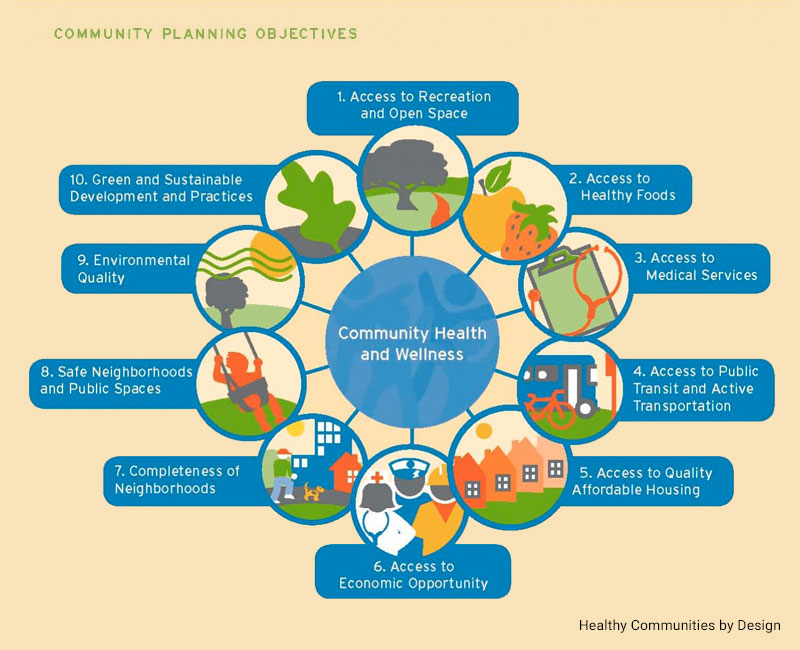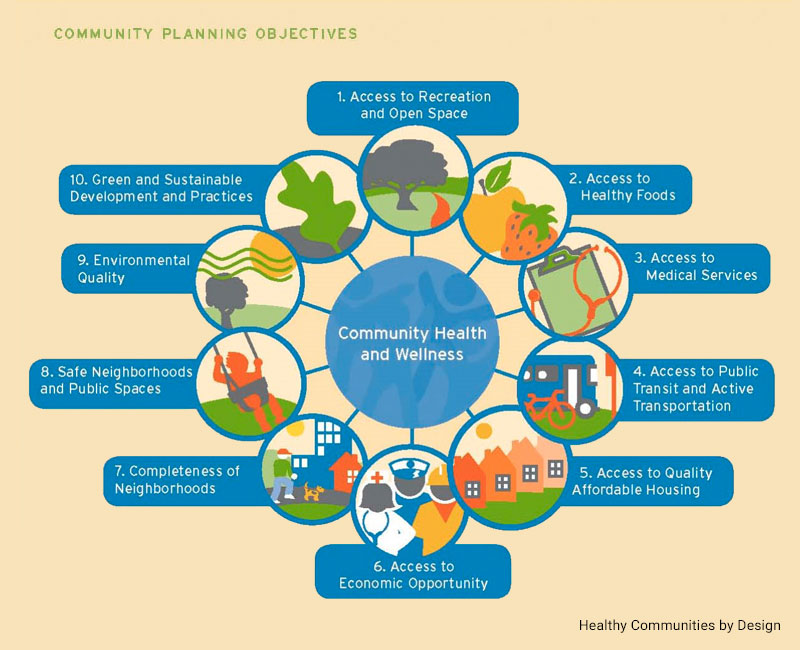How Can A Healthy Community Affects Daily Living?
Imagine a community where even the air seems to encourage you to take deeper breaths. Studies show that people living in healthier communities report not just lower rates of chronic diseases, but an overall higher quality of life. Such an environment fosters daily habits that uplift the entire neighborhood.
The concept of a healthy community is not new; it has roots in public health initiatives dating back to the early 20th century. A compelling statistic from the World Health Organization reveals that neighborhoods with access to green spaces see a 30% reduction in stress levels. Implementing urban gardens and promoting physical activity can be simple yet transformative solutions for improving daily living.

Defining a Healthy Community
A healthy community isn't just about being free from diseases. It's also about having access to resources that promote overall well-being. This includes parks, good schools, and healthcare services.
Another key factor is social connections. People in healthy communities feel safe and supported. They can rely on each other during tough times.
Environmental factors are also crucial. Clean air and water, as well as safe public spaces, make a huge difference. Strong public policies help maintain these standards.
Finally, healthy communities are inclusive. They provide equal opportunities for everyone. This means ensuring access to education, jobs, and healthcare for all residents.
Impacts of a Healthy Community on Daily Living
Living in a healthy community significantly enhances daily life. Residents often enjoy better physical and mental health. They also experience lower stress levels.
Such communities provide plenty of opportunities for exercise. Parks and recreational facilities encourage people to stay active. This helps in reducing obesity and related diseases.
Access to quality healthcare is another benefit. Regular check-ups and screenings are more available. This means early detection and treatment of illnesses.
Strong social connections in a healthy community improve emotional well-being. Having friends and neighbors to rely on creates a sense of belonging. This support network can offer help during difficult times.
Benefits for Physical Health
A healthy community encourages physical activity. People are motivated to walk, cycle, or use outdoor gyms. Public spaces make it easier to maintain an active lifestyle.
Access to healthy foods is crucial. Community gardens and farmers' markets offer fresh produce. This leads to balanced diets and better nutrition.
Clean environments are essential. Reduced pollution and green spaces improve air quality. This minimizes respiratory problems and other health issues.
Impact on Mental Health
Social interactions boost mental health. Knowing that you belong helps reduce feelings of loneliness. Communities often hold events to bring people together.
Access to mental health services is another benefit. Counseling and support groups can be found locally. Early intervention helps in managing stress and anxiety.
Natural surroundings play a role too. Being close to nature calms the mind. Parks and green areas offer spaces for relaxation.
Safety and Security
A safe environment is a cornerstone of a healthy community. Low crime rates make residents feel secure. This peace of mind impacts daily routines positively.
Well-maintained infrastructure adds to safety. Proper lighting and clean streets prevent accidents. Communities can take pride in looking after their surroundings.
Emergency services are more efficient. Quick response times from police, fire, and medical teams ensure help is available when needed. This reassurance is a key benefit of living in such communities.
Improving Health Through Community Amenities
Community amenities play a crucial role in enhancing health. Amenities like parks, gyms, and swimming pools provide residents with spaces to be active. Regular physical activity reduces the risk of many chronic diseases.
Access to healthcare facilities is another significant amenity. Clinics, hospitals, and wellness centers ensure that medical care is easily available. This leads to early diagnoses and better health outcomes.
Educational facilities also contribute to a healthier community. Libraries and community centers offer programs on nutrition and fitness. These resources empower residents to make healthier choices.
Safe spaces for social interaction are vital. Community halls and playgrounds give people places to meet and engage. Strong social ties are linked to better mental health.
Healthy Community Development and Positive Social Interaction
Developing a healthy community goes beyond physical infrastructure. It's also about fostering social connections and relationships. People thrive in environments where they feel supported and valued.
Public spaces play a key role in community interaction. Parks, community centers, and playgrounds provide meeting spots. These spaces encourage residents to come together and engage.
Community events further enhance social bonds. Activities like fairs, sports events, and cultural festivals bring people closer. They promote a sense of unity and belonging.
Educational programs also contribute to positive interactions. Workshops on health, nutrition, and fitness can be community efforts. Learning together fosters teamwork and mutual support.
Inclusivity is crucial for positive social interactions. Communities should aim to be welcoming to everyone. This means considering the needs of all age groups, backgrounds, and abilities.
Volunteering opportunities provide another avenue for connection. Residents working together on community projects build strong bonds. Shared goals and achievements strengthen the community.
The Role of Safe and Clean Environments in Healthy Communities
Safe and clean environments are fundamental to healthy communities. They significantly reduce the risk of diseases and injuries. Residents feel more secure and relaxed in such settings.
Clean air and water are vital for health. Communities benefit from reduced pollution levels. This leads to fewer respiratory problems and waterborne diseases.
Maintaining clean public spaces is crucial. Parks, streets, and recreational areas should be kept tidy. This promotes physical activities and improves mental well-being.
Safety measures add to the health of the community. Proper lighting, crosswalks, and traffic signs prevent accidents. These measures ensure that residents can move around safely.
Effective waste management systems are also important. Recycling programs and proper disposal methods keep the environment clean. A clean environment reflects a healthy community.
How Accessibility to Healthy Food Options Contributes to a Healthy Community
Having easy access to healthy food options positively impacts community health. People can make better dietary choices when nutritious foods are available. A balanced diet reduces the risk of chronic diseases.
Farmers' markets are a great resource. They offer fresh fruits, vegetables, and other nutritious items. This encourages residents to eat foods with higher nutritional value.
Community gardens are another excellent option. They allow residents to grow their own produce. These gardens also promote physical activity and social interaction.
Schools and workplaces can also play a role. Offering healthy meals and snacks supports better eating habits. Educational programs on nutrition can further promote healthy choices.
Local stores and supermarkets should stock healthy food items. This ensures that nutritious options are easily accessible. Convenience is key to maintaining a healthy diet.
The Interplay Between a Healthy Community and Mental Health
A healthy community greatly influences mental health. Social connections within the community create a sense of belonging. Feeling connected reduces loneliness and stress.
Green spaces also contribute to mental well-being. Parks and natural areas provide places for relaxation. Exposure to nature has been shown to reduce anxiety.
Access to mental health services is crucial. Communities with ample resources for counseling and therapy offer better support. Early intervention can prevent more serious issues later.
Educational programs on mental health are beneficial. Workshops and seminars help residents understand how to maintain their well-being. Knowledge empowers individuals to seek help when needed.
- Meditation classes
- Mental health awareness events
- Support groups
Physical activity also impacts mental health positively. Activities like group sports or yoga sessions boost mood. Exercise releases endorphins, which naturally improve happiness.
Finally, clean and safe environments ameliorate stress levels. Knowing that you live in a secure place brings peace of mind. This overall safety contributes significantly to emotional stability.
How Communities Can Work Towards Healthier Environments
Creating healthier environments requires collective effort and strategic planning. Communities can start by promoting greener spaces. Planting more trees and maintaining parks can improve air quality.
Recycling programs are essential. Encouraging residents to recycle reduces waste. This helps keep the environment clean and sustainable.
Improving public transportation options can also make a big difference. More buses, bikes, and walking paths reduce traffic congestion and pollution. Communities benefit from easier, cleaner ways to get around.
- Bike-sharing programs
- Electric bus fleets
- Pedestrian-friendly pathways
Access to fresh, healthy food is another key area. Community gardens and farmers' markets make nutritious food more available. These initiatives support both health and local agriculture.
Education and awareness campaigns are crucial. Teaching residents about environmental practices helps create lasting change. Workshops, flyers, and social media can all be effective tools.
Involving community members in decision-making fosters a sense of ownership. Public meetings and surveys can gather input on environmental issues. When residents feel heard, they are more likely to participate.
Frequently Asked Questions
Explore how a healthy community can improve daily life through various aspects like physical health, mental well-being, and social interactions. Here are some common questions and answers to deepen your understanding.
1. What are the key characteristics of a healthy community?
A healthy community offers access to healthcare, clean environments, and recreational spaces. These features encourage residents to live active and fulfilling lives.
Additionally, strong social support systems enhance emotional well-being. Schools and educational programs further ensure that everyone has the opportunity for growth.
2. How do parks and green spaces contribute to a healthy community?
Parks provide areas for exercise, relaxation, and social interaction. They offer a natural setting that helps reduce stress and improve mental health.
Moreover, green spaces improve air quality by reducing pollution levels. This promotes overall physical health among community members.
3. Why is access to healthcare important in a healthy community?
Access to healthcare ensures early detection and treatment of illnesses. This reduces long-term health risks and medical costs for individuals and families.
Frequent check-ups promote preventive care, contributing to overall well-being. Availability of healthcare facilities also provides peace of mind in emergencies.
4. In what ways do educational programs benefit a community's health?
Educational programs enhance knowledge about nutrition, fitness, and mental well-being. They empower residents with information to make healthier lifestyle choices.
Additionally, these programs promote inclusivity by reaching diverse groups within the community. Lifelong learning opportunities create an informed populace dedicated to collective wellness.
5. How does social interaction impact mental health in communities?
Strong social ties reduce feelings of loneliness and boost emotional resilience. Interacting with others provides support during difficult times.
Community events like festivals foster unity and belonging among residents. The sense of connection significantly improves mental health.
Conclusion
A healthy community positively impacts daily living by fostering physical, mental, and emotional well-being. Providing access to healthcare, clean environments, and educational programs enhances the quality of life for all residents.
The collective effort in creating such communities brings people closer together. Strong social ties and shared goals make these environments thrive, ultimately benefiting everyone involved. Investing in a healthy community is an investment in a better future.
